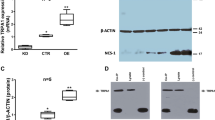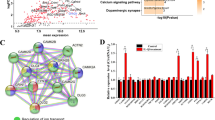Abstract
Treatment with cannabidiol (CBD) or KLS-13019 (novel CBD analog), has previously been shown to prevent paclitaxel-induced mechanical allodynia in a mouse model of chemotherapy-induced peripheral neuropathy (CIPN). The mechanism of action for CBD- and KLS-13019-mediated protection now has been explored with dissociated dorsal root ganglion (DRG) cultures using small interfering RNA (siRNA) to the mitochondrial Na+ Ca2+ exchanger-1 (mNCX-1). Treatment with this siRNA produced a 50–55% decrease in the immunoreactive (IR) area for mNCX-1 in neuronal cell bodies and a 72–80% decrease in neuritic IR area as determined with high-content image analysis. After treatment with 100 nM KLS-13019 and siRNA, DRG cultures exhibited a 75 ± 5% decrease in protection from paclitaxel-induced toxicity; whereas siRNA studies with 10 μM CBD produced a 74 ± 3% decrease in protection. Treatment with mNCX-1 siRNA alone did not produce toxicity. The protective action of cannabidiol and KLS-13019 against paclitaxel-induced toxicity during a 5-h test period was significantly attenuated after a 4-day knockdown of mNCX-1 that was not attributable to toxicity. These data indicate that decreases in neuritic mNCX-1 corresponded closely with decreased protection after siRNA treatment. Pharmacological blockade of mNCX-1 with CGP-37157 produced complete inhibition of cannabinoid-mediated protection from paclitaxel in DRG cultures, supporting the observed siRNA effects on mechanism.









Similar content being viewed by others
References
Argyriou AA, Kyritsis AP, Makatsoris T, Kalofonos HP (2014) Chemotherapy-induced peripheral neuropathy in adults: a comprehensive update of the literature. Cancer Manag Res 6:135–147
Bih CI, Chen T, Nunn AVW, Bazelot M, Dallas M, Whalley BJ (2015) Molecular targets of cannabidiol in neurological disorders. Neurotherap 12:699–730
Blaustein MP, Lederer WJ (1999) Sodium/calcium exchange: its physiological implications. Physiol Rev 79:763–854
Brenneman DE, Petkanas D, Kinney WA (2017) Pharmacological comparisons between cannabidiol and KLS-13019. J Mol Neurosci 66:121–124
Brenneman DE, Smith GR, Zhang Y, Du Y, Kondaveeti SK, Zdilla MJ, Reitz AB (2012) Small-molecule anticonvulsant agents with potent in vitro neuroprotection. J Mol Neurosci 47:368–379
Brewer GJ, Torricelli JR, Evege EK, Price PJ (1993) Optimized survival of hippocampal neurons in B27 supplemented neurobasal, a new serum-free medium combination. J Neurosci Res 35:567–576
Canta A, Pozzi E, Carozzi VA (2015) Mitochondrial dysfunction in chemotherapy-induced peripheral neuropathy (CIPN). Toxics 3:198–223
Celsi F, Pizzo P, Brini M, Leo S, Fotino C, Pinton P, Rissuto R (2009) Mitochondria, calcium and cell death: a deadly triad in neurodegeneration. Bioch Biophys Acta 1787:335–344
Chen L-H, Sun Y-T, Chen Y-F, Lee M-Y, Chang L-Y, Chang J-Y, Shen M-R (2015) Integrating image-based high-content screening with mouse models identifies 5-hydroxydecanoate as a neuroprotective drug for paclitaxel-induced neuropathy. Mol Cancer Therp 14:2206–2214
Cho CH, Lee SY, Shin HS, Philipson KD, Lee CO (2003) Partial rescue of the Na+Ca2+ exchanger (NCX1) knock-out mouse by transgenic expression of NCX1. Exp Mol Med 35:125–135
Darkovska-Serafimovska M, Serafimovska T, Arsova-Sarafinovska Z, Stefanoski S, Keskovski Z, Balkanov T (2018) Pharmacotherapeutic considerations for use of cannabinoids to relieve pain in patients with malignant diseases. J Pain Res 11:837–842
Dedov VN, Roufogalis BD (1999) Organization of mitochondria in living sensory neurons. FEBS Lett 456:171–174
Duggett NA, Griffiths LA, McKenna OE, De Santis V, Yongsanguanchai N, Mokori EB Flatters SJL (2016) Oxidative stress in the development, maintenance and resolution of paclitaxel-induced painful neuropathy. Neurosci 333:13–26
Fedorovich SV, Waseem TV, Puchkova LY (2017) Biogenetic and morphofunctional heterogeneity of mitochondria: the case of synaptic mitochondria. Rev Neurosci 28:363–373
Gornstein EL, Schwarz TL (2017) Neurotoxic mechanisms of paclitaxel are local to the distal axon and independent of transport defects. Exp Neurol 288:153–166
Guo L, Hamren J III, Eldridge S, Behrsing HP, Cutuli FM, Mussio J, Davis M (2017) Multiparametric image analysis of rat dorsal root ganglion cultures to evaluate peripheral neuropathy-inducing chemotherapeutics. Tox Sci 156:275–288
Han Y, Smith MT (2013) Pathobiology of cancer chemotherapy-induced peripheral neuropathy (CIPN). Front Pharmacol 4(156):1–16
Ivanov DP, Al-Rubai A, Grabowska AM, Pratten MK (2016) Separating chemotherapy-related developmental toxicology from cytotoxicity in monolayer and neurosphere cultures of human fetal brain cells. Tox in Vitro 37:88–96
Jordan MA, Toso RJ, Thrower D, Wilson L (1993) Mechanism of mitotic block and inhibition of cell proliferation by Taxol at low concentrations. PNAS (USA) 90:9552–9556 see Duggett
King KM, Myers AM, Soroka-Monzo AJ, Tuma RF, Tallarida RJ, Walker EA, Ward SJ (2017) Single and combined effects of Δ9-tetrahydrocannabinol and cannabidiol in a mouse model of chemotherapy-induced neuropathic pain. Brit J Pharmacol 174:2832–2841
Kinney WA, McDonnell ME, Zhong HM, Liu C, Yang L, Ling W, Qian T, Chen Y, Cai Z, Petkanas D, Brenneman DE (2016) Discovery of KLS-13019, a cannabidiol-derived neuroprotective agent, with improved potency, safety, and permeability. ACS Med Chem Lett 7:424–428
Kulbe JR, Hill RL, Singh IN, Wang JA, Hall ED (2017) Synaptic mitochondria sustain more damage than non-synaptic mitochondria after traumatic brain injury and are protected by cyclosporin A. J Neurotrauma 34:1291–1301
Kuznetsov AV, Margreiter R (2009) Heterogeneity of mitochondria and mitochondrial function within cells as another level of mitochondrial complexity. Int J Mol Sci 10:1911–1929
Lim K, See YM, Lee J (2017) A systematic review of the effectiveness of medical cannabis for psychiatric, movement and neurodegenerative disorders. Clin Psychopharm Neurosci 15:301–312
Molinaro P, Sirabella R, Pignataro G, Petrozziello T, Secondo A, Boscia F, Vinciguerra A, Cuomo O, Philipson KD, de Felice M, di Lauro R, di Renzo G, Annunziato L (2016) Neuronal NCX1 overexpression induces stroke resistance while knockout induced vulnerability via Akt. J Cerebral Blood Flow 36:1790–1803
Palty R, Silverman WF, Hershfinkel M, Caporale T, Sensi S, Parnis J, Nolte C, Fishman D, Shoshan-Barmatz V, Herrmann S, Khananshvili D, Sekler I (2010) NCLX is an essential component of mitochondrial Na+Ca2+ exchange. PNAS (USA) 107:436–441
Petroski RE, Geller HM (1994) Selective labeling of embryonic neurons cultures on astrocyte monolayers with 5(6)-carboxyfluorescein diacetate (CFDA). J Neurosci Methods 52:23–32
Rampersad SN (2012) Multiple applications of Alamar Blue as an indicator of metabolic function and cellular health in cell viability bioassays. Sensors 12:12377–12360
Ryan D, Drysdale AJ, Lafourcade C, Pertwee RG, Platt B (2009) Cannabidiol targets mitochondria to regulate intracellular Ca2+ levels. J Neurosci 29:2053–2063
Seretny M, Currie GL, Sena ES, Ramnarine S, Grant R, MacLeod MR, Colvin LA, Fallon M (2014) Incidence, prevalence, and predictors of chemotherapy-induced peripheral neuropathy: a systematic review and meta-analysis. Pain 155:2461–2470
Shprung T, Gozes I (2009) A novel method for analyzing mitochondrial movement: inhition by paclitaxel in a pheochromocytoma cell model. J Mol Neurosci 37:254–262
Sisalli MJ, Secondo A, Esposito A, Valsecchi V, Savola C, Di Renzo GF et al (2014) Endoplasmic reticulum refilling and mitochondrial calcium extrusion promoted in neurons by NCX1 and NCX3 in ischemic preconditioning are determinant for neuroprotection. Cell Death Differ 21:1142–1149
Ward SJ, McAllister SD, Kawamura R, Murase R, Neelakantan H, Walker EA (2014) Cannabidiol inhibits paclitaxel-induced neuropathic pain through 5-HT1A receptors without diminishing nervous system function or chemotherapy efficacy. Brit J Pharmacol 171:636–645
Ward SJ, Ramirez MD, Neelakantan H, Walker EA (2011) Cannabidiol prevents the development of cold and mechanical allodynia in paclitaxel-treated female C57Bl6 mice. Anesh Analg 113:947–950
Ward SJ, Riggs D, Tuma R, Kinney WA, Petkanas D, Brenneman DE (2017) Neuroprotective and anti-inflammatory effects of KLS-13019 and cannabidiol in in vitro and in vivo models of chemotherapy-induced neuropathic pain. International Cannabinoid Research Society Symposium, 22 June 2017, Montreal, Canada, 27: P1–40
Xiao H, Veridier-Pinard P, Fernandez-Fuentes N, Burd B, Angeletti R et al (2006) Insights into the mechanism of microtubule stabilization by Taxol. PNAS (USA) 103:10166–10173
Summary
Based on the high-content analysis of decreases in mNCX-1 immunoreactive area in DRG neurons, the siRNA approach confirmed the importance of this target in producing acute (5 h) protective actions of CBD and KLS-13019. Coupled with the pharmacological studies, the target knockdown observations suggested that with both cannabinoids, the mNCX-1 target was sufficient to mediate the protection from toxicity produced by paclitaxel in sensory neurons. An unexpected finding was the identification of neuritic mitochondria as a target for the protective action of these cannabinoids. A working hypothesis emerging from these studies is that the cellular location of a target may be of equal importance to the identity of that target, thereby completing or helping to define the mechanistic concept.
Funding
These studies were supported by a Grant from the National Institute on Drug Abuse of the National Institutes of Health (R41DA044898).
Author information
Authors and Affiliations
Corresponding author
Additional information
Publisher’s Note
Springer Nature remains neutral with regard to jurisdictional claims in published maps and institutional affiliations.
Rights and permissions
About this article
Cite this article
Brenneman, D.E., Kinney, W.A. & Ward, S.J. Knockdown siRNA Targeting the Mitochondrial Sodium-Calcium Exchanger-1 Inhibits the Protective Effects of Two Cannabinoids Against Acute Paclitaxel Toxicity. J Mol Neurosci 68, 603–619 (2019). https://doi.org/10.1007/s12031-019-01321-z
Received:
Accepted:
Published:
Issue Date:
DOI: https://doi.org/10.1007/s12031-019-01321-z




